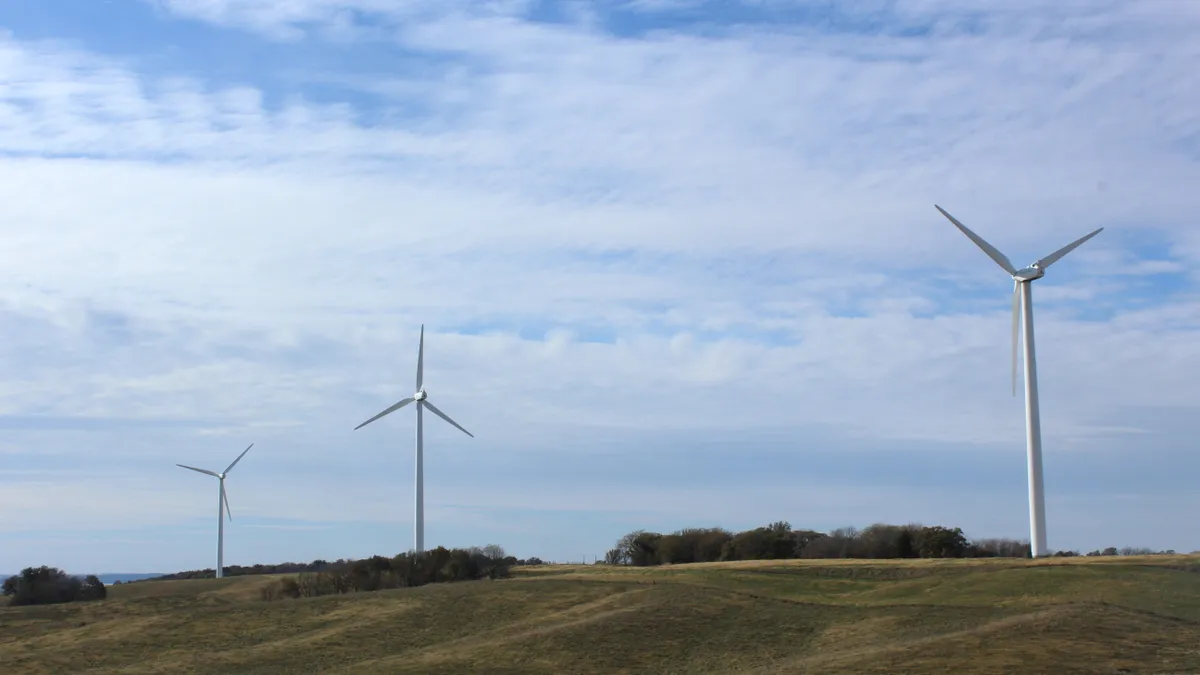Dive Brief:
- Tri-State Generation & Transmission (G&T) unveiled its Responsible Energy Plan on Wednesday, providing details on eight solar and wind projects it expects will result in 50% renewable energy use within its 43 cooperatives by 2024.
- The plan also includes the closure of all coal plants operated by Tri-State, cancellation of its Holcomb coal project in Kansas, more flexibility in allowing members to develop local, self-supplied renewable energy and support for expanded electric vehicle infrastructure and electrification.
- Whether the new plan will stem potential defections from Tri-State remains unclear. Next steps, according to Tri-State spokesman Lee Boughey, include helping employees and communities affected by the coal-related closures.
Dive Insight:
Tri-State currently generates nearly 50% of its power from coal and has been under intense pressure from its members and others to provide cleaner options.
Two of Tri-State's member co-ops — Kit Carson in New Mexico and Delta Montrose Electric Association in Colorado — have left the G&T while Colorado's La Plata Electric Association and United Power have asked the Colorado PUC to set a buy-out price to exit Tri-State's service.
United Power spokesperson Heidi Storz told Utility Dive in an email that parts of Tri-State's plan sounded promising, but since they had only received a short summary they could not comment on it.
Storz said United Power would "prefer to remain a member and have presented Tri-State with a partial requirements proposal to continue buying energy from them," but had not received any response. "We will continue to proceed with our due diligence to get an appropriate exit fee from the Colorado Public Utilities Commission so that we can make the best decision possible for our members at the appropriate time," she wrote.
Tri-State believes its new plan will help shape that decision calculus.
"We think that the responsible energy plan, which was directed by our members is very much aligned with the goals of our members to have cleaner and more flexible and more competitive power," Boughey told Utility Dive.
As part of the Responsible Energy Plan, Tri-State on Wednesday announced six new renewable projects in Colorado and New Mexico, along with two announced previously.
All told, by 2024, Tri-State expects to have more than 2,000 MW of renewable capacity on its system, including 800 MW of solar, 671 MW of wind and 600 MW of hydropower.
Tri-State first announced it would develop an energy transition plan last July. The release of its details on Wednesday comes on the heels of its Jan. 9 announcement that it would prematurely close its Escalante coal plant in New Mexico and its Craig coal plant and Colowyo Mine in Colorado.
On EVs, Tri-State plans to fund charging station expansions for each member and work with them to promote EV usage. In addition, it said it "will promote and increase its beneficial electrification, energy efficiency and demand-side management programs with its members, including support through the new Beneficial Electrification League of Colorado and other state chapters."
But United Power's biggest concern about the plan, Storz wrote, is cost. "Since Tri-State rates are already 20-30% higher than the statewide average, we need to understand how the Tri-State Plan is going to drive down the costs of energy," she wrote.
Boughey said that with the planned transition, Tri-State expects its rates to be stable if not lower.
"I think if you look at what other cooperatives in Colorado pay other power suppliers for long-term power contracts, Tri-State's wholesale rates are competitive with those other power suppliers," he told Utility Dive.
The Sierra Club and Western Resource Advocates welcomed Tri-State's latest announcement, but Sierra Club expressed ongoing concerns.
“Tri-State is making big commitments to clean energy that finally have it catching up to other utilities in the Southwest and setting the bar for Generation and Transmission cooperatives across the country,” Emily Gedeon, Conservation Director at the Colorado Sierra Club, said in a statement.
But "Tri-State still owns hundreds of megawatts of coal at the Laramie River Station in Wyoming and Springerville Unit 3 in Arizona," the statement continued.
Boughey noted that Tri-State is partial owner of the Laramie and Springerville coal plants and is unable to close them unilaterally.
The Sierra Club also pointed to what it called "Tri-State's restrictive contracts [that] force co-ops to buy 95% of their power from them, preventing co-ops from building local, more affordable power."
A contract committee that includes representatives from each of Tri-State's member co-ops is working to provide a recommendation to Tri-State's Board of Directors in April on how the G&T might expand the current limits on locally supplied energy through the use of partial requirements contract options, Boughey noted.
A previous version mischaracterized the type of hydropower on Tri-State's system. It has access to 600 MW of total hydropower capacity, both small and large scale.














